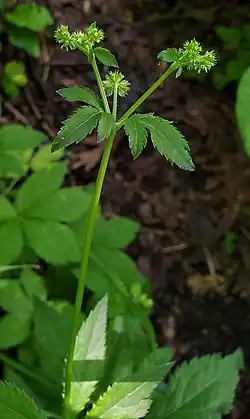Sanicula canadensis
| Sanicula canadensis | |
|---|---|

| |
| Scientific classification | |
| Kingdom: | Plantae |
| Clade: | Tracheophytes |
| Clade: | Angiosperms |
| Clade: | Eudicots |
| Clade: | Asterids |
| Order: | Apiales |
| Family: | Apiaceae |
| Genus: | Sanicula |
| Species: | S. canadensis
|
| Binomial name | |
| Sanicula canadensis | |
Sanicula canadensis, the Canadian blacksnakeroot,[1] is a native plant of North America and a member of family Apiaceae. It is biennial or perennial, and spreads primarily by seed.[2] It grows from 1 to 4.5 feet tall, and is found in mesic deciduous woodlands.[2] The whitish-green flowers with sepals longer than petals, appearing late spring or early summer and lasting for approximately three weeks, are green and bur-like.[2][3] The bur-like fruit each split into 2 seeds.[2][3] The species ranges throughout the eastern United States (excluding Maine), extending north into Quebec and Ontario, and west into Texas and Wyoming.
References
- ^ NRCS. "Sanicula canadensis". PLANTS Database. United States Department of Agriculture (USDA). Retrieved 30 October 2015.
- ^ a b c d Hilty, John (2020). "Sanicula canadensis". Illinois Wildflowers.
- ^ a b "Sanicula canadensis". Flora of Wisconsin. Wisconsin State Herbarium, University of Wisconsin–Madison.